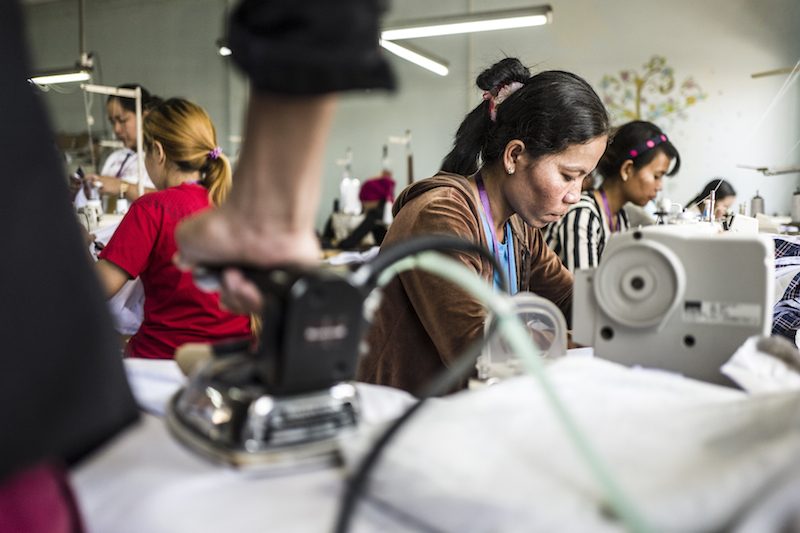Despite an onset of risks—the uncertainty of upcoming elections, a looming E.U.-Vietnam free-trade deal and a rising U.S. dollar—the immediate outlook for Cambodia’s economy remains bright, a World Bank report released on Wednesday says.
But the country will have to address looming challenges now in order to remain competitive in the future, said economists presenting the report.

“The garment sector has been the strongest driver of growth,” said World Bank senior economist Sodeth Ly at the release of the organization’s latest biannual “East Asia and Pacific Economic Update.”
“But garment is a ‘footloose’ industry—they can move quickly from one country to another,” Mr. Ly said of foreign manufacturers. “The exposure is significant.”
China—and affiliates Taiwan, Hong Kong and Macau—made up more than 90 percent of investment in the garment industry, according to the report. Local investment, by comparison, made up just 1.4 percent of the total.
Nevertheless, buoyed by increasing exports to Europe, the sector is expected to contribute 2 percentage points to growth in gross domestic product this year, propping up a robust growth rate of 7 percent for the country.
That forecast is a slight upgrade from April’s report, which predicted 6.9 percent growth next year. The World Bank also forecasts 6.9 percent growth for the next two years.
“Cambodia has been doing well and it’s very stable from a macroeconomic point of view,” said World Bank senior country economist Miguel Sanchez Martin. “But there’s a need to keep improving.”
Agriculture—depressed by low commodity prices worldwide—is contributing nothing to GDP growth, and tourist arrivals are dropping, with the rate of repeat visitors particularly low compared to neighboring countries such as Thailand, the report says.
“This is also a call for Cambodia to strengthen arrivals—diversify into ecotourism and other kinds of tourism aside from Angkor Wat,” Mr. Sanchez Martin said.
Regionally, Southeast Asia is among the fastest growing areas of the world, a rare bright spot amid the sluggishness of advanced economies, said Sudhir Shetty, the World Bank’s chief economist for East Asia and the Pacific, who appeared at Wednesday’s briefing via video link from Washington.
“The good news is that for most countries there’s a window of accommodating financial environments in advanced economies,” Mr. Shetty said, referring to low interest rates in many wealthy countries meant to encourage lending and investment.
“The bad news is that window may be closing. So action needs to be taken now.”
Mr. Ly said that for Cambodia’s garment sector, which employs more than 600,000 workers and accounted for some $6 billion in exports last year, this meant improving competitiveness amid several headwinds.
“We’ve seen wages increase very quickly, and we’ve seen the dollar also continue to appreciate,” he said. “Before, the U.S. was the largest market [for garment exports] so it was OK. Now it’s Europe and the exchange rate becomes a factor.”
With costs rising, garment and footwear manufacturers will have to move to higher-value production or diversify into other goods, Mr. Ly said.
Mr. Sanchez Martin said this was already happening at some factories, with manufacturing moving away from simple shirts toward clothes with added value, such as embroidery.
“The final product has a little bit more,” he said. “That’s how Cambodia is remaining competitive.”
Broader risks to the economy, he added, include uncertainty surrounding upcoming elections, which cause a cyclical dip in foreign investment.
Also potentially disruptive is a free trade deal between the E.U. and Vietnam, agreed on in December, but yet to be ratified. Much of Cambodia’s competitive advantage in exporting to Europe will be lost due to the deal, Mr. Ly said.
Comparing the situation to trying to outrun a tiger, Mr. Ly noted, however, that Cambodia had been able to maintain market share in the U.S. despite competing with Vietnam on a level playing field after losing its preferential access.
“You don’t have to outrun the tiger. You just have to outrun the other guy,” he said. “We don’t have to compete with Vietnam, but other inefficient producers.”
In an adjustment from previous reports, the World Bank predicted a gradual slowdown for China’s economy—downplaying the risk of a shock to neighboring countries —as well as for Cambodia’s construction sector, which was particularly strong this year.
Though some have warned of a credit bubble forming amid rapid growth in the construction sector, Mr. Sanchez Martin said it was not a major concern as the industry was almost entirely built on foreign investment.
“In the unlikely event that a bubble bursts, we don’t see an impact on Cambodia as you see in other countries. Because it’s mostly foreign investors, they will mostly be affected.”




